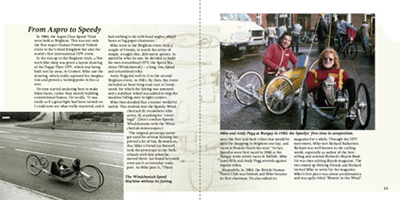
..........................................................................................................................................................................................................
from bicycle to superbike. tony hadland & mike burrows. hadland books hardback. 188pp illus. £25

berkely, california-based design and type foundry, emigré, at one time sold mouse-mats, in the days before mice featured little red leds, with the legend 'design is a good idea'. it's a statement that works on at least two levels, an undeniable truth on either. design could conceivably be defined as neither style nor substance, but an equitable marriage of the two, a means of maintaining functionality and looking good at the same time.
as the world's motor manufacturers spend ever more time in the wind tunnel (as do many cycle companies these days) and equally the same amount of time analysing computer renders of the latest in car body styles, the motor vehicles rolling off the production line would be a tad less attractive if left in their original chassis state. in this case, design is a very good idea. even the ever-changing yet simply conceived products that festoon our pride and joy in the bikeshed have been pored over by both designers and engineers to ensure they look every bit as good as they hopefully function. you didn't think those tyre treads actually had to change every couple of years, did you?
however, we didn't get to where we are now completely by accident. the bicycles available on the shop floor of your nearest independent cycle retailer are a compromise between what is technically possible and the often oddly luddite restrictions imposed by the unione cycliste internationale. though racing a bicycle may well be the very last thing that you and i would consider, the manufacturers of high-end velocipedes have need of acquiescing to the dictates of aigle, for it is not altogether unlikely that a portion of their customer base will have no other purpose in mind.

one notable british bicycle engineer who has probably every bit as much experience of the brick-wall that is the uci as has graeme obree, is mike burrows. if the name seems vaguely familar, you will most likely have heard of him in connection with chris boardman's 1992 olympic gold winning lotus carbon bicycle. that particular design, with its monoblade carbon fork and single rear chainstay seemed a portent of the way the bicycle was destined to go, particularly when pinarello built a remarkably similar machine for indurain and olano. that we are still aboard bicycles that feature the perennial double-diamond configuration is a situation for which responsibility must rest squarely with the uci.
chris boardman's introduction remarks: "The UCI had taken one look and re-written the rules - specifying a bicycle must be made out of 3 main tubes - to ensure it was outlawed. But 5 years later, the UCI revoked its ban on monocoque frames, a decision that would precipitate a renaissance in bicycle design (and throw the UCI's technical commission into turmoil for the next twenty years) " that revision would then be revoked once more to provide us with our present predicament.

but the lotus bike and the '92 olympics were 'simply' mike burrows' fifteen minutes of fame, as even a cursory glance through the latter portion of from bicycle to superbike will avow. though burrows has aimed his engineering and design experience more towards the recumbent or human powered vehicle side of the equation, he was also the gent almost singlehandedly responsible for shifting road bikes away from the traditional to the sloping top tube via his three-sizes-fit-all giant tcr design.
"...by lowering the top-tube, you break the visual linkage with size becasue the seat post is now so long, and it can be made aerodynamic. The repositioned frame will be slightly stiffer in torsion and slightly more forgiving in vertical compliance."
mike burrows himself is responsible for the narrative accompanying his often revolutionary 38 years of bicycle and hpv design, but the bulk of the burrows story has been furnished by author and publisher tony hadland. this he has done in a largely unconventional manner, but one that offers a compulsive and engrossing read. aside from detailing mike burrows' biography from his birth in april 1943, there are many illustrative excerpts from burrows' writings for several cycling publications throughout the years. most of these are of a technical nature, yet written in a fashion that makes comprehension almost second nature.

"The answer is 98.4. That's right! Not only is 98.4 degrees (F) the ideal operating temperature for your cycle's 'engine', it is also the percentage efficiency of its transmission system, when correctly lubricated. [...] you might reasonably expect the chain to be placed on an altar of design efficiency to be revered by one and all, not least by bicycle designers. But no! Instead we see ill-conceived, folding, fashionable, plastic answers to the world's commuting problems..."
the book's design and format is well-conceived and must be considered an essential read for those even tentatively interested in the career and design genius of mike burrows. though that lotus bike will always hover in the background as public testament, there is little doubt that the man has scarcely received the recognition he is undoubtedly due. in mitigation, hadland does point out that some of this is due as much to burrows' reticence as it is a perceived national prejudice against those working and thinking outside the box, particularly in the field of bicycle design. however, short interviews with those who know him well, do much to redress the balance; all that's needed to complete the circle is for my reader to purchase a copy and spread the word.
an excellent christmas present for a cyclist near you.
buy 'from bicycle to superbike'
saturday 19 november 2016
 ..........................................................................................................................................................................................................
..........................................................................................................................................................................................................